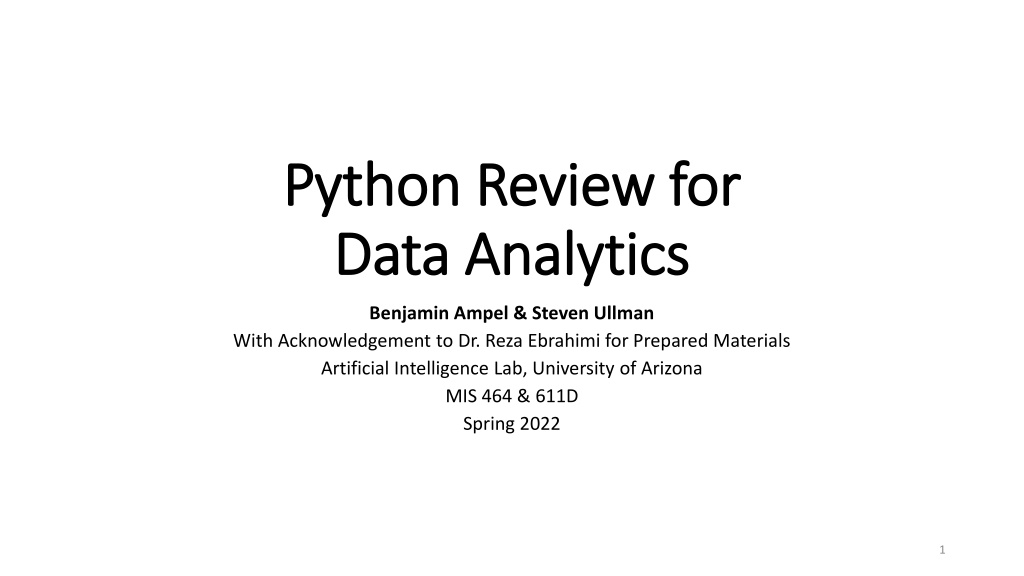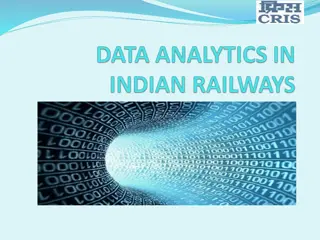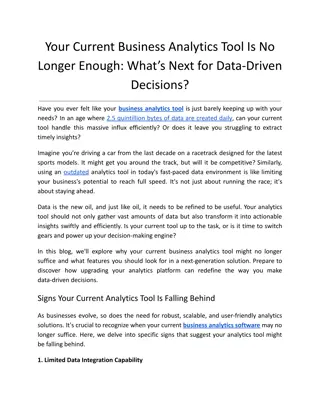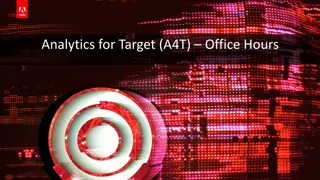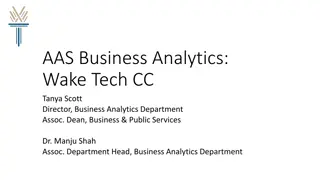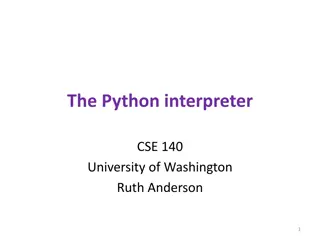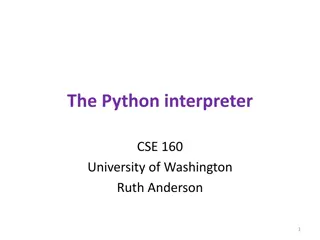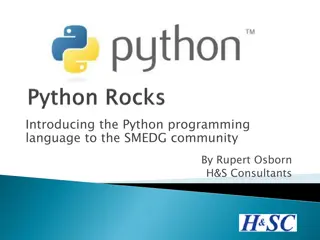Python Review for Data Analytics Tutorial
This Python review tutorial for data analytics covers essential programming concepts, data manipulation, and visualization using Python. Presented by Benjamin Ampel and Steven Ullman from the Artificial Intelligence Lab at the University of Arizona. The tutorial aims to enhance understanding of language syntax, data handling, and visualization techniques in Python for data analytics purposes.
Download Presentation

Please find below an Image/Link to download the presentation.
The content on the website is provided AS IS for your information and personal use only. It may not be sold, licensed, or shared on other websites without obtaining consent from the author.If you encounter any issues during the download, it is possible that the publisher has removed the file from their server.
You are allowed to download the files provided on this website for personal or commercial use, subject to the condition that they are used lawfully. All files are the property of their respective owners.
The content on the website is provided AS IS for your information and personal use only. It may not be sold, licensed, or shared on other websites without obtaining consent from the author.
E N D
Presentation Transcript
Python Review for Python Review for Data Analytics Data Analytics Benjamin Ampel & Steven Ullman With Acknowledgement to Dr. Reza Ebrahimi for Prepared Materials Artificial Intelligence Lab, University of Arizona MIS 464 & 611D Spring 2022 1
Outline Outline Python Review for Data Analytics Development Environment Setup (Required for this tutorial) Programming Essentials Data Types Data Structures Control Flow Statements Functions Classes and Objects Putting It All Together Exhaustive Enumeration Example (Finding Cube Roots) Bisection Search Example (Finding Square Roots) Obtain and Process Data from Kaggle with Python Data Visualization with Python 2
About the TAs About the TAs Benjamin Ampel Artificial Intelligence Lab University of Arizona BAmpel@arizona.edu Steven Ullman Artificial Intelligence Lab University of Arizona StevenUllman@arizona.edu We are 4th year PhD students in the AI Lab, focused on AI-enabled cybersecurity. If you have questions, the best way to reach us is to send an email or visit our cubicle located on the 4th floor (Cubicle # 35, to the right of the entrance of the MIS offices). 3
About this Tutorial About this Tutorial This Python Review Session is focused on the fundamentals of programing and language syntax. There are four learning objectives: 1. Understanding the language syntax. 2. Understanding the language features useful for data analytics. 3. Understanding loading and preprocessing the data with python. 4. Understanding visualization of the data with Python. Advanced topics such as dynamic programming and implementation of search algorithms are beyond the scope of this tutorial. In-depth tutorials for building machine learning pipelines will be provided later in the course (March 23). 4
Credit Credit This tutorial is based upon the following books and websites: https://towardsdatascience.com https://www.tutorialspoint.com https://www.w3schools.com https://machinelearningmastery.com https://Kaggle.com https://runawayhorse001.github.io 5
Development Environment Setup (Required) Development Environment Setup (Required) For the purposes of this course, all Python programming can be done in a Google Colab instance (https://colab.research.google.com/) A free account can be made with your UArizona email. A script with all the code found in this tutorial can be found at this link. The link is also available on the course webpage as Python Tutorial Colab Notebook 6
Programming Essentials Programming Essentials In this review, we will go over five essential Python programming structures for data mining tasks: 1. Data Types Variables Strings 2. Data Structures Lists Dictionaries 3. Control Flow Statements If, For, and While Break and Continue 4. Functions 5. Classes and Objects 7
Data Types: Variables and Assignments Data Types: Variables and Assignments A variable points to data stored in a memory location. This memory location can store different values. E.g., integers, real numbers, Booleans, strings, etc. Binding: Assigning an object in memory to a variable . 8
Data Types: Strings Data Types: Strings Python string module provides a variety of methods for strings: upper()/lower(): Converts a string to its uppercase/lowercase variant. find(): Yields the offset where the first occurrence of the substring occurs. replace(old,new): Replaces the old occurrence of the substring old with the substring new. Strings need to be surrounded by 9
Data Structures: Lists Data Structures: Lists The list data structure provides a way to store arrays of objects. We can construct lists of any data type. There are built-in methods for performing actions on lists: append(): Adds an item to the end of the list. sort(): Orders the list (default is from lower to higher if numeric). Reminder, Python starts at 0. Calling the 0thitem of the list would have printed Dog 10
Data Structures: Dictionaries Data Structures: Dictionaries The dictionary consists of pairs of items, each containing a key and value pair. When constructing a dictionary, each key is separated from its value by a colon (i.e., key : value ). Items are separated by commas. 11
Control Flow Statements: Control Flow Statements: if and and for We may need to execute a statement only if a condition holds. if (x <0): Print x is negative elif (x==0): print x is zero Condition Pay attention to the indentation! Pay attention to == as opposed to = What happens if you assign x = 2 and execute the above code? We may need to repeat execution of a statement for several times. counter = 0 for char in MIS464 : if char == 4 : counter = counter +1 What would be the value of counter after executing? 12
Control Flow Statements: Control Flow Statements: While While is used for repeating statements until a certain condition holds. Condition Loop Body The loop body should contain code that eventually makes the loop condition false (loop needs to terminate). 13
Control Flow Statements: Control Flow Statements: Break, and Continue , and There are two mechanisms to explicitly terminate (make the loop condition false): Break: Terminates the loop immediately. Continue: Terminates the current iteration of the loop body, and execution continues with the next iteration of the loop. For char in MIS611D : if char == 6 : continue print(char) For char in MIS611D : if char == 6 : break print(char) What would be the output? What would be the output? 14
Control Flow Statements: Control Flow Statements: Break, and Continue (cont d) (cont d) , and The following figure compares the control flow for break (left) and continue (right). 15 https://www.tutorialspoint.com
Functions Functions Functions allow us to reuse our statements. Two main benefits of using functions: Reusability: Helps avoiding redundant statements. Readability: The code will be more concise and easier to understand. Using functions entails 1) defining and 2) calling them. 1. Defining a function named max 2. Function Call x and y are function parameters. print (max(4,0)) 4 and 0 are called arguments of this function call. 16
Functions: Keyword Arguments Functions: Keyword Arguments Consider the following print function: def printName(firstName, lastName, reverse): if reverse: print lastName + ', ' + firstName else: print firstName, lastName The following ways of calling printName are equivalent: printName( John , Doe , False) printName( John , Doe , False) printName( John , Doe , reverse = False) printName( John , lastName = Doe , reverse = False) printName(lastName= Done , firstName= John , reverse=False) Using Keyword Arguments in Calling Functions Keyword Arguments should always appear after regular arguments. 17
Functions: Default Values Functions: Default Values Default values allow calling a function with fewer than the specified number of arguments. We change the previous print function as follows: def printName(firstName, lastName, reverse = False): if reverse: print lastName + ', ' + firstName else: print firstName, lastName The following function calls are all allowed: printName( Olga , Puchmajerova ) printName( Olga , Puchmajerova , True) printName('Olga', Puchmajerova , reverse = True) Default Value The last two function calls are semantically equal (i.e., yield the same output) Which one of the above function calls exploits default value? 18
Classes and Objects Classes and Objects Python is a procedural, object-oriented language. Such languages support user-defined types. Classes: user-defined type definition (e.g., Course). Objects: the instantiation of these types (e.g., MIS464). We define a class named Course with two attributes (title and level) and one method (printName). Every class has an initializer function that assigns values to attributes. (Used when we instantiate the class). 19
Classes and Objects (contd) Classes and Objects (cont d) Now, we can instantiate the courseclass to get an MIS464 and MIS611D object 20
Putting All Together: Exhaustive Enumeration Putting All Together: Exhaustive Enumeration Example (Finding Cube Roots) Example (Finding Cube Roots) [page 21 in [page 21 in Guttag s Guttag s book] book] The following snippet returns y such that x=y3. #Find the cube root of a perfect cube x = int(raw_input('Enter an integer: ')) ans = 0 while ans**3 < abs(x): ans = ans + 1 if ans**3 != abs(x): print x, 'is not a perfect cube' else: if x < 0: ans = -ans print 'Cube root of', x,'is', ans Raw_input function takes user input. This means it calculates the cube root of any given integer which is a perfect cube. Let us trace the code for x=27, x=25, and x=-9 together! Why is this approach called exhaustive search ? 21
Putting All Together : Exhaustive Enumeration Putting All Together : Exhaustive Enumeration Example (Finding Cube Roots) (cont d) Example (Finding Cube Roots) (cont d) [page 21 in Guttag s book] Let s rewrite the exhaustive enumeration seen in the previous example in a different way. #Find the cube root of a perfect cube x = int(raw_input('Enter an integer: ')) for ans in range(0, abs(x)+1): if ans**3 >= abs(x): break if ans**3 != abs(x): print x, 'is not a perfect cube' else: if x < 0: ans = -ans print 'Cube root of', x,'is', ans We replace the while loop with a for loop and break. Can you guess what is the functionality of range in this code snippet? 22
Putting All Together: Bisection Search Example Putting All Together: Bisection Search Example (Finding Square Roots) (Finding Square Roots) [page 28 in [page 28 in Guttag s Guttag s book] book] Approximation class encapsulates the functionality of approximating square roots via binary search. Class Approximation: def findRoot(x, epsilon): if x < 0: return None numGuesses = 0 low = 0.0 high = max(1.0, x) ans = (high + low)/2.0 while abs(ans**2 - x) >= epsilon: numGuesses +=1 if ans**2 < x: low = ans else: high = ans ans = (high + low)/2.0 return ans app = Approximation() print (app.findRoot(24, 0.01)) Definitions Returns float y such that y2 is within epsilon of x. In this example, we encapsulate the functionality in a class. Calls Let us trace the code line by line together! 23
Python Quick Reference Python Quick Reference [complete version on page 287 of Guttag s Guttag s book] book] Common operations on numerical types i+j, i-jare the sum and subtraction. i*j is the product of i and j. i//j is integer division. i/j is i divided by j. In Python 2.7, when i and j are both of type int, the result is also an int, otherwise the result is a float. i%j is the remainder when the int i is divided by the int j. i**j is i raised to the power j. Comparison and Boolean operators x == yreturns True if x and y are equal. x != y returns True if x and y are not equal. <, >, <=, >= are greater, lower, greater or equal, lower or equal a and b is True if both a and b are True, and False otherwise. a or b is True if at least one of a or b is True, and False otherwise. not a is True if a is False, and False if a is True. [complete version on page 287 of 24
Python Quick Reference (contd) Python Quick Reference (cont d) [complete version on page 287 of page 287 of Guttag s Guttag s book] book] [complete version on Common operations on sequence types seq[i]returns the ith element in the sequence. len(seq) returns the length of the sequence. seq1 + seq2 concatenates the two sequences. seq[start:end] returns a slice of the sequence. for e in seq iterates over the elements of the sequence. Common string methods s.count(s1) counts how many times the string s1 occurs in s. s.find(s1) returns the index of the first occurrence of the substring s1 in s. s.lower(),s.upper() converts uppercase letters to lowercase and vice versa. s.replace(old, new) replaces all occurrences of string old with string new. s.rstrip() removes trailing white space. s.split(d) Splits s using d as a delimiter. Returns a list of substrings of s 25
Python Quick Reference (contd) Python Quick Reference (cont d) [complete version on page 287 of page 287 of Guttag s Guttag s book] book] [complete version on Common list methods L.append(e)adds the object e to the end of L. L.insert(i, e)inserts the object e into L at index i. L.extend(L1)appends the items in list L1 to the end of L. L.remove(e) deletes the first occurrence of e from L. L.index(e)returns the index of the first occurrence of e in L. L.pop(i)removes and returns the item at index i. Defaults to -1. L.sort()has the side effect of sorting the elements of L. Common operations on dictionaries len(d)returns the number of items in d. d.keys()returns a list containing the keys in d. d.values()returns a list containing the values in d. d[k]returns the item in d with key k. Raises KeyError if k is not in d. d.get(k, v)returns d[k] if k in d, and v otherwise. d[k] = vassociates the value v with the key k. del d[k]removes element with key k from d. Raises KeyError if k is not in d. for k in diterates over the keys in d. 26
Data Analytics Components Data Analytics Components After introducing the essentials of Python programing, we are ready to move on to data analytics. Data analytics often encompasses the following three phases: 1) Preprocessing: Unifying (merging) different sources, changing the level of granularity (e.g., daily to monthly), etc. 2) Visualization: Visualizing the data (or results of analysis) to provide insights. 3) Model building: Using machine learning algorithms to build a model that provides a business value. While Phase 1 is often a prerequisite, the order of Phases 2 and 3 is interchangeable and iterative. iterative 27
Obtain and Process Data from Kaggle with Obtain and Process Data from Kaggle with Python Python Kaggle is a subsidiary of Google, which allows data scientists and regular users to share datasets for data analytics. Serves a community of data scientists and machine learning engineers. Hosts competitions to solve data science challenges. Visit Kaggle.com Search for West Nile Virus Prediction. Search Datasets here 28
Obtain and Process Data from Kaggle with Obtain and Process Data from Kaggle with Python (cont d) Python (cont d) West Nile Virus (WNV) was released in a Kaggle competition in 2015. Competition s task: Predict WNV in mosquitoes across Chicago. WNV often spreads to humans through infected mosquitos. Prize: $40,000 The figure shows the competition s scoreboard: Prediction Accuracy # of tries Winner Method: Deep Learning ... Method: Ensemble of Random Forests ... 29
Obtain and Process Data from Kaggle with Obtain and Process Data from Kaggle with Python (cont d) Python (cont d) As noted, data analytics very often starts with data preprocessing. After data preprocessing, deep learning or any other machine learning methods can be applied to build a model. For data pre-processing most Kaggle participants use Python along with two libraries called Pandas and NumPy. Pandas: Offers data structures and operations for manipulating numerical tables. NumPy: Apackage for scientific computing that support N-dimensional arrays. import pandas as pd External Package alias After importing any package the alias can be treated in the same way as an object. E.g., pd.read_csv() is a function call to read a comma separated file. import numpy as np 30
Obtain and Process Data from Kaggle with Python Obtain and Process Data from Kaggle with Python (cont d) (cont d) After importing Pandas library, we can use its built-in functions and data structures. We present three useful examples from WNV dataset: Load the weather comma separated file from WNV dataset: weather = pd.read_csv( path\to\weather.csv ) Replace missing values with a scalar: weather = weather.replace( - ,100) Join Datasets on a specific criterion weather_stn1 = weather[weather[ Station ]==1] weather_stn2 = weather[weather[ Station ]==2] weather = weather_stn1.merge(weather_stn2, on='Date') Join Criterion 31
Read From and Write Into Files Read From and Write Into Files Sometimes we simply want to interact with a text or CSV file without using Pandas. Python has built-in read and write functions (less verbose than Java or C++). To read or write to a file, first we need to create a file handler. f = open( test.txt', w ) W creates a file for writing. 'r opens an existing file for reading. a opens an existing file for appending. File name /path mode When the handler is created, we can use it to interact with the file as follows: f.read()returns a string containing contents of the file. f.readlines()returns a list containing lines of the file. f.write(s)write the string s to the end of the file. f.writelines(L)Writes each element of L to the file. f.close()closes the file. How can we open a file both for reading and writing? 32
Visualizing Data with Python Visualizing Data with Python Three main recent packages are most used for data visualization in Python: Matplotlib: The most common library (low level: most flexible) Pandas Visualization: An abstraction on Matplotlib (high level: less flexible) (Part of Pandas data processing library introduced in Review I) Seaborn: Provides more professional and aesthetic look than the other two. Due to the high usage and flexibility, we focus on Matplotlib in this tutorial. The fundamentals of visualization that are covered are common for all three packages. 33
Visualizing Data with Python: Data Types Visualizing Data with Python: Data Types Before we can visualize data, we need to understand which type of data we are trying to visualize. In the simplest form, a dataset includes attributes and their values. Commonly encountered attribute types in data analytics are as follows: Categorical attributes: Relates to quality and includes two main types: Nominal: No order (e.g., coursetitle: data analytics and data science ). Ordinal: Represent order (e.g., course level: under grad , grad , or PhD seminar ). Numerical attributes: Discrete: Can only take certain values (e.g., # of students enrolled in a course). Continuous: Can be described by a number on real line (e.g., duration of a class). 34
Visualizing Data with Python: Common Visualizing Data with Python: Common Visualization Types Visualization Types We cover the most common types of visuals seen in data science reports or papers. These visuals assist gaining a better insight from the data and include: Scatter Plots: Useful for visualizing categorical data points (samples) Line Charts: Useful for continuous or categorical data E.g., changes of one variable as a function of another variable Histograms: useful for showing the distribution of all types of data Bar Charts: Useful for categorical data with not many different categories 35
Visualizing Data with Python: Package Visualizing Data with Python: Package Installation and Datasets Installation and Datasets Matplotlib can be installed by running either of the following commands: pip install matplotlib conda install matplotlib We use two data sets for the visualization purposes: Wine Reviews: Available from Kaggle at https://www.kaggle.com/zynicide/wine-reviews Iris: One of the oldest data analytics data sets available from UCI repository at: https://archive.ics.uci.edu/ml/datasets/iris. Data points are flowers. To import the above data sets, we can use Pandas as seen in Review I: import pandas as pd iris = pd.read_csv('iris.csv', names=['sepal_length', 'sepal_width', 'petal_length', 'petal_width', 'class'] pip comes with standard python installation. Conda requires to be installed as well. Attribute Name 36
Visualizing Data with Python: Package Visualizing Data with Python: Package Installation and Datasets (cont d) Installation and Datasets (cont d) After loading the data with Pandas, we can see the attributes and values by executing the following statement: print(iris.head()) Attributes Values Class: Flower type wine_reviews = pd.read_csv('winemag-data-130k-v2.csv', index_col=0) wine_reviews.head() Attributes Values 37
Visualizing Data with Python: Scatter Plots Visualizing Data with Python: Scatter Plots To visualize Iris data in a scatter plot, first we need to import pyplot from matplotlib package. import matplotlib.pyplot as plt Now, we can use plt object to create the scatter plot from the data: Title # create a figure and axis fig, ax = plt.subplots() # scatter the sepal_length against the sepal_width ax.scatter(iris['sepal_length'], iris['sepal_width']) # set a title and labels ax.set_title('Iris Dataset') ax.set_xlabel('sepal_length') ax.set_ylabel('sepal_width') Data Points https://towardsdatascience.com Y Axis X Axis 38 Lines beginning with # are comments (will not be executed by Python interpreter).
Visualizing Data with Python: Scatter Plots Visualizing Data with Python: Scatter Plots (cont d) (cont d) To add to the readability of the visualization, we color each data points by its class (flower type). # create color dictionary colors = {'Iris-setosa':'r', 'Iris- versicolor':'g', 'Iris-virginica':'b'} # create a figure and axis fig, ax = plt.subplots() # plot each data-point for i in range(len(iris['sepal_length'])): ax.scatter(iris['sepal_length'][i], iris['sepal_width'][i],color=colors[iris['cl ass'][i]]) # set a title and labels ax.set_title('Iris Dataset') ax.set_xlabel('sepal_length') ax.set_ylabel('sepal_width') https://towardsdatascience.com How many classes exist in the dataset? 39
Visualizing Data with Python: Line Charts Visualizing Data with Python: Line Charts (cont d) (cont d) The following snippet plots a line chart for Iris dataset. # get columns to plot columns = iris.columns.drop(['class']) # create x data x_data = range(0, iris.shape[0]) # create figure and axis fig, ax = plt.subplots() # plot each column for column in columns: ax.plot(x_data, iris[column], label=column) # set title and legend ax.set_title('Iris Dataset') ax.legend() https://towardsdatascience.com Legend Value of sepal_length for each Data Point (in blue) What are x and y axes in this example? 40
Visualizing Data with Python: Histograms Visualizing Data with Python: Histograms The following snippet plots a Histogram for Wine Review dataset. # create figure and axis fig, ax = plt.subplots() # plot histogram ax.hist(wine_reviews['points ]) # set title and labels ax.set_title('Wine Review Scores ) ax.set_xlabel('Points ) ax.set_ylabel('Frequency') https://towardsdatascience.com Based on the histogram, how rare is it to have wine with 97.5 point rate? Does the histogram remind you of any particular data distribution? 41
Visualizing Data with Python: Bar Charts Visualizing Data with Python: Bar Charts The following snippet plots a bar chart for Wine Review dataset. # create a figure and axis fig, ax = plt.subplots() # count the occurrence of each class data = wine_reviews['points'].value_counts() # get x and y data points = data.index frequency = data.values # create bar chart ax.bar(points, frequency) # set title and labels ax.set_title('Wine Review Scores ) ax.set_xlabel('Points') ax.set_ylabel('Frequency') https://towardsdatascience.com Based on the bar chart, what is the most frequent rate for wine in this data set? Does the bar chart remind you of any particular data distribution? 42
